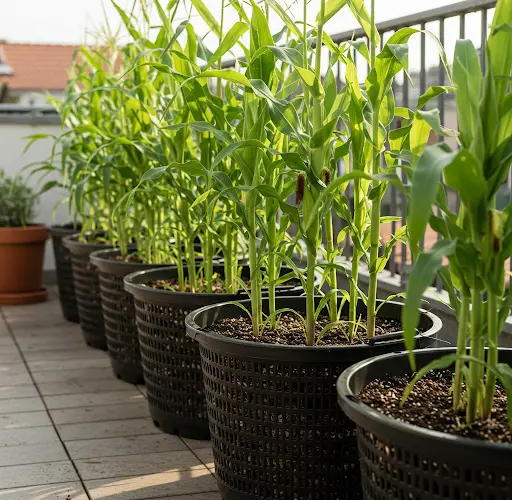Growing Corn on the Terrace: A Beginner’s Guide to Growing Corn at Home
Growing corn at home might sound like something that requires a big backyard or a farm, but the truth is—you can grow corn right on your terrace, balcony, or rooftop with ease. With a little care and the right setup, even first-time gardeners can enjoy the satisfaction of harvesting fresh corn straight from their own space.
This guide will walk you through everything you need to know about growing corn at home, even if you have limited space. Whether you’re looking to grow sweet corn for fresh eating or a decorative variety for fun, this method works well for beginners and small-space gardeners alike.
Why Grow Corn at Home?
Corn is not only a staple food around the world but also a rewarding crop to grow. When harvested fresh, the taste and sweetness far surpass anything you’ll find at the grocery store.
Some of the reasons to grow corn at home include:
-
Freshness and flavor: Nothing beats freshly picked corn.
-
Easy for beginners: Corn is relatively low-maintenance.
-
High yield per plant: One plant can give 1–2 full ears.
-
Decorative and edible: Tall, green stalks add life to any terrace or balcony.
-
Family-friendly project: Kids love watching it grow tall and fast.
Best Corn Varieties for Terrace Gardening
Not all corn is created equal, especially when space is limited. Here are some varieties ideal for home gardening:
-
Sweet Corn (e.g., Honey Select, Golden Bantam) – Delicious and tender, best for fresh eating.
-
Miniature or Dwarf Varieties (e.g., Baby Corn, Sweet Painted Mountain) – Compact and space-saving.
-
Multi-colored Corn (e.g., Glass Gem) – Beautiful and great for ornamental or popping uses.
Choose the variety that suits your space, taste, and intended use.
What You’ll Need
Before planting, gather the following materials:
-
Corn seeds
-
Large containers or grow bags (at least 12–15 inches deep and wide)
-
Rich, well-draining soil or potting mix
-
Organic compost or fertilizer
-
A sunny location (at least 6 hours of sunlight daily)
-
Watering can or hose with gentle spray
Step-by-Step Guide to Growing Corn on the Terrace
Step 1: Choose the Right Container
Corn plants grow tall and have deep roots, so choose a container that’s at least 12 inches deep. You can use large pots, grow bags, or even sturdy plastic tubs. Make sure the container has good drainage holes.
If space allows, plant several containers in a block formation. Corn pollinates better in clusters than in single rows.
Step 2: Prepare the Soil
Use nutrient-rich potting soil mixed with compost or well-rotted manure. Corn is a heavy feeder and thrives in fertile, well-aerated soil.
Fill your containers almost to the top, leaving about 1–2 inches for watering space.
Step 3: Plant the Seeds
Plant corn seeds about 1 inch deep and 6–8 inches apart. If you’re planting multiple seeds in one container, space them evenly.
Water gently after planting to moisten the soil without washing away the seeds.
Seeds typically germinate within 7–10 days, especially in warm temperatures.
Step 4: Provide Sunlight and Watering
Corn loves sun, so place your containers in a spot that receives at least 6 hours of direct sunlight each day. More sun means sweeter, stronger plants.
Water regularly to keep the soil consistently moist but not soggy. During hot weather, you may need to water once or even twice a day.
Supporting Growth
Corn stalks grow tall, so strong stems are important. If your plants become top-heavy, use bamboo stakes or twine to support them.
Apply a balanced organic fertilizer or compost tea every 2–3 weeks to support healthy growth and development.
Pollination Tips
Corn is wind-pollinated, which can be a challenge in small or enclosed spaces. To ensure good pollination and full ears:
-
Grow corn in blocks of at least 4–6 plants rather than single rows.
-
When tassels (male flowers) appear at the top of the stalks and silks (female flowers) appear on the ears, gently shake the stalks daily or transfer pollen by hand using a soft brush.
This helps ensure that each kernel on the cob is properly fertilized.
Harvesting Corn
Corn is usually ready for harvest 60–100 days after planting, depending on the variety.
To check for readiness:
-
The silks turn brown and dry out.
-
Kernels are plump and release a milky liquid when pierced.
-
The ear feels full and firm.
Harvest by pulling down and twisting the ear from the stalk.
Extra Tips for Success
-
Don’t overcrowd your containers—corn needs space to thrive.
-
Avoid waterlogging by ensuring good drainage.
-
Use mulch to retain moisture and regulate soil temperature.
-
Rotate crops if you reuse soil to avoid nutrient depletion.
-
Plant in succession (every 2–3 weeks) for a steady harvest throughout the season.
Final Thoughts
Growing corn on the terrace is not only possible—it’s practical, fun, and rewarding. With minimal effort and a few containers, you can grow your own sweet, golden ears of corn at home, even if you’re limited to a small urban space.
This beginner-friendly approach helps you take one more step toward self-sufficiency and fresh, homegrown food. Give it a try, and you might find yourself growing corn every season!



